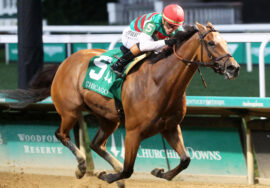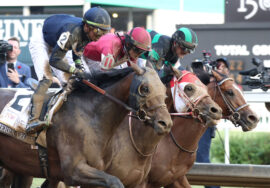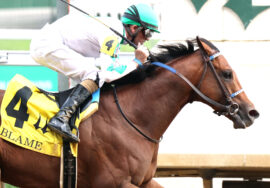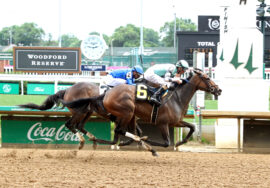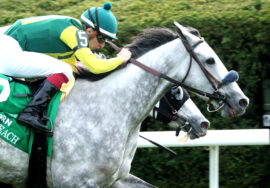
Hamelback: ‘We’re over-regulating at expense of horsemanship’
National HBPA news release by Jennie Rees/Eric Hamelback photo by Denis Blake
SHELBYVILLE, Ind. (Wednesday, June 14 ,2023) —Eric Hamelback, CEO of the National HBPA, told an assembly of track superintendents Tuesday that simply piling on more regulations will not make racing safer and that it is hamstringing the very horsemanship that is needed now more than ever. Hamelback further said that unsoundness doesn’t “just start at the track” and that the breeding industry needs to take a hard look at itself as well.
Hamelback spoke at the 22nd annual Track Superintendents Field Day staged June 11-13 at Horseshoe Indianapolis. The event brought together 62 participants representing 40 racetracks and coming from as far away as Saudi Arabia. Conference topics included soil science, turf-course engineering, advances in sod, preparing for emergency situations and best practices for track and regulatory staffs, emerging technology (including driverless mowers) managing nuisance Canada geese and hiring strategies.
Not surprisingly, the speakers who attracted the most questions were Ann McGovern, who oversees the Racetrack Safety Program for the Horseracing Integrity & Safety Authority (the Authority), and Hamelback. The National Horsemen’s Benevolent & Protective Association (NHBPA) is among the entities challenging the constitutionality of the federal legislation enabling the Authority and its broad powers.
While their organizations are at odds over how to best achieve national uniformity while improving safety, Hamelback and McGovern agreed on the importance of track superintendents and their crews tasked with caring for their racing and training surfaces.
McGovern, who has lengthy experience as a racetrack executive, called track superintendents “an unsung heroes position.”
“You guys can make or break a racetrack literally,” she said Monday. “Giving you the tools to do what you need to do is extremely important for management to recognize. I think HISA can help with that.”
McGovern said that HISA has contracted with Mick Peterson PhD’s Lexington-based Racing Surfaces Testing Laboratory to do a baseline examination of each track before its racing season begins. Track superintendents in HISA-compliant states are tasked with daily surface reporting and maintenance logs, for which McGovern said they are working on a phone app for convenience.
“We do not want to run your racetrack,” she said. “We do not want to manage your racetrack. We do not want to be track superintendents. However, we want to gather research data … so that you can do the best job you can with the track you’ve been given.”
Hamelback’s message during his Tuesday address: The regulation and new track policies piling on in the wake of the high-profile horse deaths this spring does not make horses safer but in fact has the opposite result.
“We’re over-regulating at expense of horsemanship,” he said. “We cannot just make things safer by creating more regulations. If we continue to force regulations more and more and more, based on perceptions, that is literally moving horsemanship away from the industry.”
Horsemanship includes many facets of the industry, including track superintendents and their crews, Hamelback said. He also pushed back against the perspective that “perception is reality,” saying, “reality is reality” and that policy changes should make a difference and not simply be window dressing in an attempt to placate detractors.
“What I advocate for is a reality that is based in science and facts and creates good change for the industry,” Hamelback said. “But what is safety? Safety is a condition. It’s not an absolute… We all know that working and dealing with horses has inherent risks. There are factors in racing that none of us, no matter how good we are at our jobs, can control. I think most of us in this room also understand that there are people out there who don’t care about that as a factor. They just want racing gone. But it’s our job to embrace change, move through the journey to make this environment as safe as possible.
“You track supers know this very well, changing conditions (can be hampered by) lack of resources, funding sometimes. We can have engineers tell us exactly what to do, but we can’t always afford it. (Or) we don’t work for a track that wants to give it to us. But this group better start making that demand… If it’s an extra tractor, an extra conditioner, an extra set of hands, this industry needs it.”
Hamelback said to truly make change for the better, the industry must “peel the onion back,” looking at everything that can impact horses’ welfare, including going back well before they arrive at a racetrack. He pointed out that the legislation enabling the HISA Authority includes breeders as well as racehorse trainers and owners in the definition of a “covered person.”
“And rightly so,” Hamelback said. “If this is an industry initiative, pushed on us by Congress, everybody in the industry ought to be stepping up.”
Hamelback: Unsoundness doesn’t ‘just start at the racetrack’
Hamelback — whose long career includes serving as farm manager and general manager of a couple of America’s top breeding establishments — made it clear he believes the breeding industry must step up and be part of the solution by taking a hard look at how it raises future racehorses.
“Is the industry breeding to race or are they breeding to sell?… We need to be breeding to race,” Hamelback told the audience. “That product that we see out there starts somewhere. Who is managing the breeding industry? We need to get to that point. I’m telling you as a long-time farm manager, issues of unsoundness do not just start at the racetrack. It also starts at the farm.
“…. We need to get a better definition of pre-existing injuries. Because to my knowledge, transphyseal bridges, transphyseal screws, periosteal strippings don’t fall into that category as we speak. But those are done on the farms — corrective surgeries with the intent of having a better commercial product. That hurts at the racetrack, in my opinion…. We need more monitoring of the breed from the breed registry. Because as an industry, peeling back the layers, we need to look at all aspects of it.”
As it stands, none of HISA’s regulations pertain to those breeding and raising the future racehorse. Part of that is because HISA says it doesn’t have control over a horse until it has had its first race or first published workout, which HISA has interpreted as being at a licensed racetrack or training facility.
Hamelback said that a published work should also cover the timed eighth- and quarter-mile workouts at the 2-year-olds in training sales. He said HISA furthermore should change the regulations to where a horse’s reported vet records include any procedures done on it as a foal, yearling or 2-year-old preparing to be sold.
McGovern was asked during her address Monday why those areas aren’t covered by HISA.
“Many of the horses at the 2-year-old sales haven’t even been registered (with HISA) yet,” she said. “But that is something that from a legal standpoint we need to look at what our range can be, what we can do. My non-HISA opinion, my personal opinion, is that this is an area that really needs a little bit of oversight.”
And when might HISA regulate corrective surgeries performed on yearlings? event moderator Nancy Holthus asked McGovern.
Those surgeries “potentially could affect them breaking down during their racing career,” Holthus said. “A lot of times the first to be blamed is the racetrack, and that’s not the culprit.”
Responded McGovern: “I don’t know when, but HISA’s board and the racetrack safety is aware and has gotten a lot of input from folks wanting to look at certain procedures that are done on yearlings and what happens at the 2-year-old sales. We just don’t have the bandwidth right now, and we have to check if we even have the jurisdiction to do that.”
Jockeys: Racing is safer than ever but crop rule should change
Tuesday’s program included a Q&A with Horseshoe Indy riding stalwarts Deshawn Parker and Rodney Prescott, who between them have won more than 10,000 races.
Both jockeys said they believe horse racing is safer now than at any time in their long careers, which for Parker began in 1988 and for Prescott in 1994. They agreed that a critical factor is for the riders to have a good relationship with the track superintendent, where potential issues with a track surface can be discussed and addressed.
“I think the 30 years I’ve been riding, safety has come a long way,” Prescott said. “Track surfaces have improved. We’re definitely going in the right direction there. We don’t run as much on a bad surface (as in the past). Rails have come a long way. Starting gates have come a long way.”
However, both jockeys said the HISA crop rule and its associated penalties does not make racing safer for horses and should be changed.
The Authority’s rules limit hitting a horse on the hind quarters to a total of six times with the specialized foam-padded crops made out of shock-absorbing materials and weighing no more than eight ounces. Jockeys are fined a minimum of $250 and suspended for a day for striking a horse between seven and nine times, with penalties increasing after that. A horse struck 10 or more times is disqualified from purse money.
“I can’t stand it,” Parker said of the rule. “I actually have (a one-day suspension) coming up Thursday because I hit seven times. It was neck and neck to the wire, so I’m trying to win a race (which he did). Personally I’ve offered like eight times (as an alternative), but I think six is not enough. The whips we’re using now are pretty much like pool noodles. A couple of years before we were getting fined for not riding hard enough to the wire. Now we’re getting fined because we’re riding too hard to the wire. I feel now we’re not able to ride a race to win.”
Concurred Prescott, referencing public perception: “The whip rule in effect now is designed for the head of the lane to the wire. The whip we use is designed for the head of the lane to the wire. They didn’t take into consideration the 2-year-old you’re trying to get to the track in the morning. Or the first-time starter you’re trying to get out of the paddock and to the pony, or to walk into the gate. It’s a tool to get a horse to go forward. From my point of view as a jockey, that’s the one spot we went backward in safety since I started.”
Videos of Eric Hamelback addressing the Track Superintendents Field Day
Part 1: ‘Safety is a condition, not an absolute‘
Part 2: ‘We are over-regulating at the expense of horsemanship’
Part 3: Safety needs to start with those producing our future racehorses







